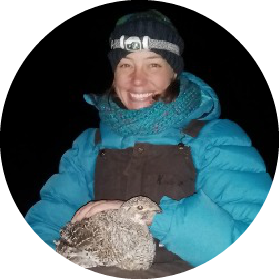

Dr. Yanbin Yin, Professor
University of Nebraska-Lincoln
Zygnematophyceae are the algal sisters of land plants. We sequenced four genomes of filamentous Zygnematophyceae, including chromosome-scale assemblies for three strains of Zygnema circumcarinatum. We inferred traits in the ancestor of Zygnematophyceae and land plants that might have ushered in the conquest of land by plants: expanded genes for signaling cascades, environmental response, and multicellular growth. Zygnematophyceae and land plants share all the major enzymes for cell wall synthesis and remodifications, and gene gains shaped this toolkit. Co-expression network analyses uncover gene cohorts that unite environmental signaling with multicellular developmental programs. Our data shed light on a molecular chassis that balances environmental response and growth modulation across more than 600 million years of streptophyte evolution.
Dr. Kelly Vining
Professor, Oregon State University
Mints (Mentha spp.) are grown for their distilled monoterpene-rich oils, which are used in many consumer products. Black Mitcham has long been the standard peppermint cultivar. Black Mitcham is a sterile allohexaploid (2n=6x=72). Three Mentha species are hypothesized to have contributed subgenomes to Black Mitcham: diploids M. longifolia and M. suaveolens (2n=2x=24), and octoploid M. aquatica (2n=8x=96). This project aims to unravel the subgenome structure of Black Mitcham peppermint by comparing genomes of the putative diploid progenitor species to that of Black Mitcham. Elucidating the peppermint subgenomes will aid studies of mint monoterpene biosynthesis and has the potential to provide insight into Black Mitcham’s sterility.
Complete diploid and Polyploid assembly with OmniC
Thomas Swale
Scientific Project Manager, Cantata Bio
Mukulika Ray, Postdoctoral Researcher
Brown University
Temperature is one important abiotic regulator of gene expression that substantially affects biological functions. How increasing temperature affects gene transcription has not only helped us understand the process of transcription per se but is vital for managing the effects of global changes in temperature on living organisms, including humans, plants, and animals, for economic purposes.
Heat stress (HS), caused by increasing temperature beyond physiological limits, leads to activation of stress response genes and repression of constitutive gene expression, both essential for cell survival. Heat shock is an excellent model for understanding the mechanisms of transcription. A key question is: How are genes specifically targeted for activation or repression upon heat stress? Although extensive studies have elucidated the mechanisms that drive HS-induced activation of stress response genes, little is known about the mechanisms that repress thousands of constitutive genes. The mechanisms of heat shock-regulated transcription have been first and most thoroughly studied in Drosophila which we used as our model system where the GA-binding TF GAF was shown to be essential for activation of genes upon heat stress. Here, we show that another GA-binding transcription factor (TF) protein CLAMP (Chromatin-linked adaptor for MSL complex proteins) that can compete with GAF for its binding sites is essential for repression of constitutive genes upon heat stress. We also identified CLAMP-associated 3D loop anchors using Hi-ChIP both before and after heat shock. Furthermore, CLAMP-bound loop anchors that overlap with genes that are normally actively transcribed and and then become repressed after heat shock are characterized by a different set of chromatin marks and interacting TFs than, those which are normally paused and become activated after HS. Overall, we propose that the function of different GA-binding TFs in mediating 3D interactions distinguish genes that are activated from those that are repressed upon heat stress.
Dr. Myriam El Khawand
Head of Customer Success, Cantata Bio
Myriam takes you through setting up and running the Omni-C assay in your lab.
What is 3D Genomics and Why It Matters
Dr. Cory Padilla
Product Management, Cantata Bio
Join us for an insightful talk on 3D Genomics, where we explore the vital role of chromosome folding and spatial organization in gene regulation, and its seamless integration with multi-omic strategies such as transcriptomics and epigenomics. Discover real-world applications of 3D Genomics in gene regulation and oncology, including oncogenic regulation in multiple myeloma and enhancer hijacking in prostate cancer. Plus, learn how to effectively incorporate 3D Genomics into your research.
What you’ll learn:
~ How 3D Genomics fits into the multi-omic toolbox (including ChIP-seq & ATAC-seq).
~ What information 3D Genomics uniquely unlocks.
~ Why integrating 3D Genomics provides valuable insight into your research.
Dr. German Lagunas-Robes
Ph.D. Candidate, UC Riverside
Find out how the social organization of ant colonies is genetically determined.
Dr. Andrea De La Torre
Associate Professor, North Arizona University
White pine blister rust caused by the pathogen Cronartium ribicola is a devastating fungal disease affecting all five-needle (Strobus) pines in North America. Warming climates bring significant challenges to the management, breeding, and conservation of these economically and ecologically important pine species. In this study, we use a multi-omics approach that includes genomic, transcriptomic, and epigenomic analyses to understand the processes and mechanisms of disease resistance and how to ensure health resilience under climate change. In addition, we have developed several resources for public use such as a de novo transcriptome and a new, chromosome-scale 26.5 Gb genome assembly for sugar pine (Pinus lambertiana).
Dr. Stephanie Galla
Assistant Professor in Avian Biology, Boise State University
Columbian Sharp-tailed Grouse (Tympanuchus phasianellus columbianus; hereafter CSTG) were widespread in shrub-steppe ecosystems in western North America, but experienced significant decline due to anthropogenic change. CSTG occupy less than 10% of their former range, have been extirpated from four US states, and are considered state endangered in Washington. Human mediated translocations of birds to reconnect and reestablish populations have been unsuccessful and conservationists agree that information regarding CSTG population structure and differentiation would help identify ideal source populations for improved success. To facilitate the characterization of genome-wide variation, estimate population structure, connectivity, and demographic histories of CSTG, we have partnered with Cantata Bio to produce a HiRise Dovetail reference genome assembly. Preliminary statistics indicate this genome is 1.07 Gb in size and is highly contiguous, with a high N50 (70,819,304) and 98.04% of orthologs found in eukaryotic databases present. This genome will allow accurate estimates of inbreeding (via runs of homozygosity) to prioritize populations in need of intervention. The characterization of adaptive loci will allow us to understand local adaptation of populations across the western US and its effects on translocation success. Finally, this reference genome will be the first for Sharp-tailed Grouse (T. p. spp.), providing an important global genomic resource for a genus where most extant taxa are in decline (Lesser Prairie-chicken, T. pallidicinctus), endangered (Attwater’s Prairie-chicken, T. cupido attwateri), or extinct (Heath Hen, T. c. cupido).
Zoe Clarke
Ph. D. Candidate, University of Toronto
Natural experimental models of hepatocellular carcinoma (HCC) development from a hepatitis B virus (HBV) infection are limited due to its high host specificity1. The woodchuck (Marmota monax) is an ideal experimental model for HCC caused by HBV, because most woodchucks naturally develop HCC as a result of chronic woodchuck hepatitis virus (WHV) infection on an intact immunological background2. Having a biologically relevant model to human disease helps ensure that therapeutics tested in these models will be safe and effective when translated to human research. However, the mechanisms by which WHV causes cancer are only speculated3, and the host immune response is very diverse and not fully understood4. This consequently limits our capacity to design treatments to fight human HBV and HCC. Studying the response of individual cells at a single-cell level from chronic WHV infections will help uncover cell-type specific vulnerabilities and the role of different immune cells in the infection. Single-cell RNA-sequencing, spatial transcriptomics, and multiome (paired single-nucleus RNA-sequencing and single-cell ATAC-sequencing) have been performed across different regions of healthy, infected and cancerous woodchuck liver tissue. These data will facilitate the generation of a single-cell transcriptomic map of the healthy woodchuck liver that can be used as a reference against which to compare diseased tissue. Gene expression enrichment analysis, interpretation of viral gene expression, and analyzing sites in which the virus has integrated itself into the host genome will be used to improve our understanding of HCC development in the context of both the tumour microenvironment and cell-specific carcinogenesis.
1. Littlejohn, M., Locarnini, S. & Yuen, L. Origins and evolution of hepatitis B virus and hepatitis D virus. Cold Spring Harb. Perspect. Med. 6, a021360 (2016).
2. Guo, W.-N., Zhu, B., Ai, L., Yang, D.-L. & Wang, B.-J. Animal models for the study of hepatitis B virus infection. Zool. Res. 39, 25–31 (2018).
3. Bruni, R. et al. Lack of WHV integration nearby N-myc2 and in the downstream b3n and win loci in a considerable fraction of liver tumors with activated N-myc2 from naturally infected wild woodchucks. Virology 345, 258–269 (2006).
4. Michalak, T. I. Diverse Virus and Host-Dependent Mechanisms Influence the Systemic and Intrahepatic Immune Responses in the Woodchuck Model of Hepatitis B. Front. Immunol. 11, 853 (2020).
Dr. James Santangelo
Postdoctoral Fellow, Nielsen Lab, UC Berkeley
White clover (Trifolium repens L.; Fabaceae) is an important forage and cover crop in agricultural pastures around the world and is increasingly used in evolutionary ecology and genetics to understand the genetic basis of adaptation. Historically, improvements in white clover breeding practices and assessments of genetic variation in nature have been hampered by a lack of high-quality genomic resources for this species, owing in part to its high heterozygosity and allotetraploid hybrid origin. To address this gap, we recently used PacBio HiFi and chromosome conformation capture (Dovetail Omni-C) technologies to generate a chromosome-level, haplotype-resolved genome assembly and a functionally annotated haploid mapping assembly for the species, which drastically improve on the existing reference assembly in both contiguity and assembly accuracy. In this talk, I will discuss key results from ongoing projects that are leveraging this new assembly, including: (1) Tracing white clover’s colonization history out of the Mediterannean and around the world, (2) Understanding the genome’wide signatures of adaptation to climate in both its native and invaded ranges, and (3) Investigating parallel genome-wide signatures of natural selection in response to urban environments around the world.











